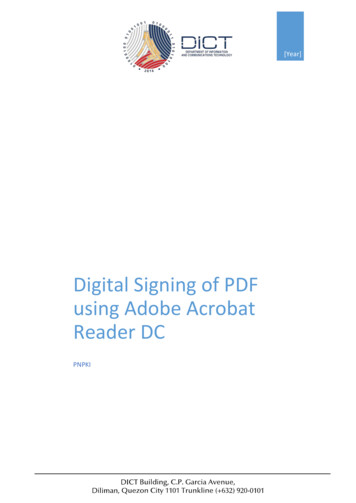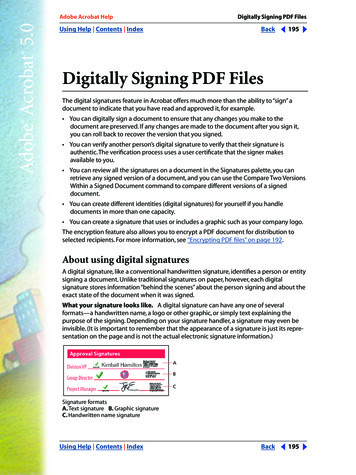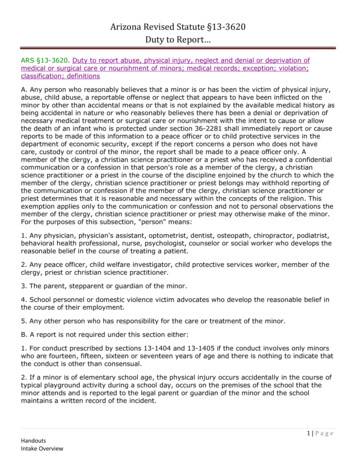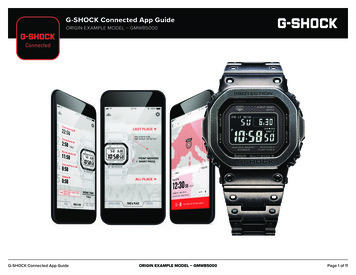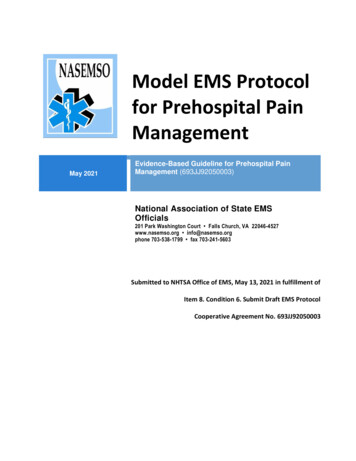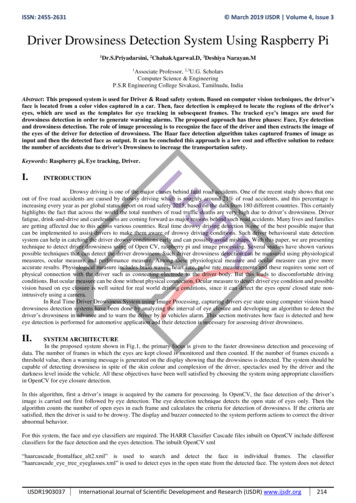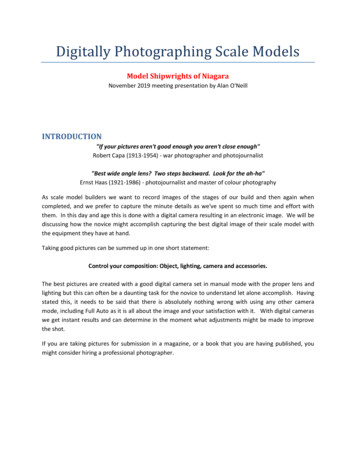
Transcription
Digitally Photographing Scale ModelsModel Shipwrights of NiagaraNovember 2019 meeting presentation by Alan O'NeillINTRODUCTION"If your pictures aren't good enough you aren't close enough"Robert Capa (1913-1954) - war photographer and photojournalist"Best wide angle lens? Two steps backward. Look for the ah-ha"Ernst Haas (1921-1986) - photojournalist and master of colour photographyAs scale model builders we want to record images of the stages of our build and then again whencompleted, and we prefer to capture the minute details as we've spent so much time and effort withthem. In this day and age this is done with a digital camera resulting in an electronic image. We will bediscussing how the novice might accomplish capturing the best digital image of their scale model withthe equipment they have at hand.Taking good pictures can be summed up in one short statement:Control your composition: Object, lighting, camera and accessories.The best pictures are created with a good digital camera set in manual mode with the proper lens andlighting but this can often be a daunting task for the novice to understand let alone accomplish. Havingstated this, it needs to be said that there is absolutely nothing wrong with using any other cameramode, including Full Auto as it is all about the image and your satisfaction with it. With digital cameraswe get instant results and can determine in the moment what adjustments might be made to improvethe shot.If you are taking pictures for submission in a magazine, or a book that you are having published, youmight consider hiring a professional photographer.
NOV 2019MSoN Presentation - Digitally Photographing Scale Modelsby Alan O'NeillTHE SUBJECTModels can be built in an endless number of scales and with a varying amount of detail. The longer andtaller the model the more difficult it might be to keep everything in focus. Overhanging parts might hideyour special details in shadows. You will need to consider all this and more when setting up the modelfor photography. Consider what you want seen and any effect you want displayed in your image. Thereis no wrong effect if the end result is what you intended, though you must be prepared to accept thatyour artistic talents might not be fully appreciated by others. Consider the composition below. do Iwant to see my ragged old jeans and shoes or focus on my fantastic catch and his sorrowful looking facecomplete with the lure and snagged weeds?Look at me, or.look at my fish!2
NOV 2019MSoN Presentation - Digitally Photographing Scale Modelsby Alan O'NeillLIGHTINGVisible light is a portion of the electromagnetic spectrum that our eyes can identify. These light wavesconsist of wavelengths from 700 nm (nanometres or billionths of a meter) at the red end of thespectrum to 400 nm at the violet end. White light contains all wavelengths, such as from the sun, and itis referred to as polychromatic light.(no copyright infringement is intended)Mick Lissone has released this “Rainbow Light” image under Public Domain license.It means that it can used and modified for personal and commercial iew-image.php?image 68532&picture rainbow-lightObjects appear as different colours because they absorb some of the wavelengths or colours, andreflect, or transmit the others which are the colours we see. White objects appear white because theyreflect all colours. Black objects absorb all colours so no light is reflected.The retina of our eyes contains two types of photoreceptors, rods and cones. The cones detect colour.The rods only let us see things in black, white and grey. Our cones only work in bright light which is whywe cannot see colours at night. It is estimated that we can recognize some 10 million different colours.Sunrise, the golden hour at Lake Gibson - A.O'NeillHarsh strong lighting is normally less desirable than soft diffused or indirect lighting (i.e. morningsunlight). The first hour after sunrise is considered the golden hour for soft outdoor photography withnatural lighting. If you are outdoors, an overcast day is preferable to a cloudless day. Relocating undera covered porch or awning may well help create a better image on a sunny day. Indoor diffused lightingvia the sun through a window might be better than illumination by the use of lamps.3
NOV 2019MSoN Presentation - Digitally Photographing Scale Modelsby Alan O'NeillFront Lighting directly in front of the subject. All shadows are around the back of the subject. If thesubject is at all reflective the light may shine back to the camera producing a glare. Front lighting alsotends to make the subject look flat and two dimensional.Side Lighting reveals shape and texture by creating shadows to the opposite side. Lighting from bothsides will create cross shadows. This can be diffused by putting a tissue paper between the light sourceand the subject.Back Lighting can result in a dark subject (in a shadow) but this can be corrected with a plus two (over)exposure setting adjustment on the camera allowing more light exposure time. This is sometimes a" EV" button resulting in an smaller aperture or faster shutter speed adjustment. Back lighting can giveyou a halo effect around the subject which can be a rather nice effect in some cases.Lens Hoods protect against direct sunlight that might create a flare effect in your image.Camera pop-up flash lighting in daylight outdoors can eliminate direct shadows without loss to theeffect of natural lighting.External flash lighting can be redirected to one side or above the subject to bounce the light back off awall or backdrop as soft lightening.On my build table - A. O'NeillIf indoors, one indirect light source might not be enough as it may create shadows. A second lampproviding indirect lighting from another direction might help reveal your models details. Directing thelight to bounce off a back drop and/or reflect off white card stock in front of the model may produce the4
NOV 2019MSoN Presentation - Digitally Photographing Scale Modelsby Alan O'Neillresults you are seeking. Diffused lighting can be deflected onto your model off the overhead roomceiling. It can also be created by directing your light to pass through tissue paper and onto your model.Trial and error will find what works best for you in that moment.Moving a light source (that is without a reflector or lens that focuses the output) further away from thesubject, reduces the intensity of the light by a factor of four times. This is referred to as the inversesquare law. If your lighting is too bright try moving it back away from the subject.A trick to eliminate low shadows on the subject is to use tin foil to reflect the light upwards onto theunderside of your model. This is done by bunching up the tin foil into a low wall placed on the table top.Backdrops can be anything including the standard stiff card or foam board, or cloth. In any case theyshould normally be pristine (no blemishes or wrinkles) so as not to distract from your model. They neednot always be white. Think colours! Sometimes photographing a part on a black, blue or light greenbackground helps make them pop.THE IMAGE FILE TYPEDigital images are usually saved by default as JPEG or .jpg extension type files. JPEG is the acronym forJoint Photographic Experts Group which is the group that created the format. For the most part JPEGfiles are fine but you should be aware that every time they are saved they are compressed. Eachcompression results in a loss of digital information or detail. Eventually the sharpness of the image willbe compromised. For this reason you should never work on (make adjustments to) your original imageas it will always be the best version. Work on a copy of the original version. I use JPEG files almostexclusively.Example JPEG photo of framing - detail loss due to file compression - A. O'NeillOther file formats to consider using are TIFF and RAW.A TIFF or .tif extension type file is much better than a JPEG or PNG as it contains more detail but at theexpense of file size. it will be much, much larger in size. TIFF is the acronym for Tagged Image FileFormat. This format stores raster graphic images such as used by graphic artist and professionalphotographers. When I was ordering drawing images from the National Maritime Museum I couldn'tdecide what image type to purchase and they recommended the TIFF format for details. When I5
NOV 2019MSoN Presentation - Digitally Photographing Scale Modelsby Alan O'Neilldownloaded my TIFF images I was surprised to find JPEG versions included. They did this so I couldbetter appreciate the difference in the images. RMG/NMM Item No. J2934 is the lines draft of HMSElephant. The TIFF image was 647 times larger, at 739,464 Kb (kilobytes) versus 1,143 Kb for the JPEGversion. 1 Kb is 1000 bytes of information!Snips of NMM plan #J2934 of HMS Elephant framing details - JPEG to left and TIFF to right - A.O'NeillIf you are attempting to capture and keep as much detail as possible use the TIFF file format.The digital camera RAW file format was created by Adobe and contains unprocessed and uncompresseddata available to the camera sensor. It is not an image. It is pure and untouched raw data and needs tobe converted by other software to become a viewable image. On a 6 MegaPixel camera, a 2Mb JPEGimage file would be 8Mb when saved as RAW data. This type format is used by many professionals withhigh end digital cameras.And just so you are aware, a PNG or .png extension type file is better than a JEPG. It is generally a largerfile size than a JPEG and sometimes smaller than a TIFF. PNG is the acronym for Portable NetworksGraphic file format and although it can be used for a photograph it is generally used for text documentsand web pages as it does not support the CMYK (Cyan/Magenta/Yellow/Key or Black) colour paletteused in printing.6
NOV 2019MSoN Presentation - Digitally Photographing Scale Modelsby Alan O'NeillTHE CAMERASimplified sketch depicting the working parts of a digital camera - A. O'NeillHow does a digital camera work? The camera is a secure light proof box. When the button is depressedthe mirror swings out of the way and a shutter opens allowing light to pass through to the image sensor.The amount of light is limited by the aperture setting and the shutter speed. The shades and colours oflight reaching the image sensor is saved on a memory card.Most people have some sort of digital camera, be it built into a cell phone, a small compact digitalcamera, or one with interchangeable lenses (DSLR type). You should also consider the possibilities ofthe computer accessory, a small webcam, that might be used to capture images inside the hull of yourmodel ship.My cell phone is an older Samsung Galaxy S5. It's camera has a 16Mp (MegaPixel) sensor and a f/2.2lens with a 31mm focal length. The image I see on the cell phone screen is what I capture. I can adjustthe picture size (resolution/compression). I can compensate for low light. I can select ISO mode,Metering mode, selective focus, flash, timer, High Dynamic Range (HDR) imaging and make moviesamong other options. I use this camera all the time these days as it is convenient.We have an older small compact digital Canon PowerShot A520 camera. It has a 4Mp sensor with 4times optical zoom or 140mm focal length. I have a choice of using the direct (see through) view finderor the 1.8 inch LCD Monitor. The image I see on the LCD monitor is what I capture. I can set it to Auto,Tv (Shutter Speed Priority), Av (Aperture Priority), Manual, Portrait, Landscape, Night Scene, SlowShutter, Special Scene, or Stitch Assist. I can also change the resolution/compression. There is a flash.It has macro, a timer, and digital zoom. It will also do movies. As it has a macro lens it might likely bebetter than the cell phone, except it might only save 1/4 the pixels for an image.7
NOV 2019MSoN Presentation - Digitally Photographing Scale Modelsby Alan O'NeillOur DSLR (Digital Single Lens Reflex) camera is a Nikon D5100. It has a 16.2Mp DX format sensor; ISO100 - 6400 sensitivity; 3 inch LCD monitor size; 95% reflex mirror viewfinder coverage; bayonet lensmounting. It will save RAW or JEPG files, has electronic 1/4000 to 30 second shutter speed range, andelectronic timer. Selections for different modes are: Manual, Aperture, Shutter, Program, Full Auto, fullauto without Flash, Landscape, Portrait, Macro, Effects and much more.We have two lenses for use with the DLSR camera. One is a Nikon HB 57 DX SWM VR ED NRI - 1.4m /4.79 ft Φ5B with A/M selection and VR ON/OFF. The other is a Nikon DX 18-55mm VR 1:3.5 - 5.6G AF-SNikor.My home computer is enhanced with an add on Logitech HD Webcam C615. It records high definition1080p video and has 8Mp photo capable with auto focus and built in microphone. It has a 3 footextension cable and is tripod mountable.Confused? What does all this mean? What is really important?You must read you instruction manuals to appreciate what your equipment offers you, but the followingshould be of assistance.Mega Pixel or Mp: 4Mp, 8Mp and 16Mp is the maximum number of million pixels the image cancontain. The larger the number the higher the resolution or better the image will be. Each digital photois comprised of an array of tiny squares of colour shades. An image that measures 4,000 x 3,000 pixels isa 12Mp photo.A 16Mp cell phone camera cannot be compared to a 16.2Mp DSLR camera as the DSLR camera is ahigher quality piece of equipment (combination of sensor and lens).The stated Mp of the camera is the maximum possible. If you increase the compression setting ofimage you will decrease the number of pixels or have less Mp of data for the image.theAUTO mode: the camera sets everything. Your responsibility is lighting, aiming and shooting.8
NOV 2019MSoN Presentation - Digitally Photographing Scale Modelsby Alan O'NeillThe Exposure Triangle shows the relationship between aperture, ISO and shutter speed - A. O'NeillAv or A mode - Aperture Mode: you pick the aperture size and the camera selects the shutter speed.Use aperture mode when the depth of field is most important.Sketch depicting the aperture opening versus F-stop setting - A.O'NeillAPERTURE: varying size hole inside the camera lens; defined as f-stops (Note: the smaller the apertureopening the larger the number); larger f-number results in a slower shutter speed so the camera mustbe held steady (via a tripod) for a longer time period.9
NOV 2019MSoN Presentation - Digitally Photographing Scale Modelsby Alan O'NeillHMS Oriole Jackstaff - AO'NeillPORTRAIT: focus is on the subject; soft blurry background; smaller depth of field or f-numberThe Green Ribbon Trail - A.O'NeillLANDSCAPE: focus seems to be on everything; larger depth of field or larger f-number; *focus is actual1/3rd before and 2/3rds beyond what you've actually focused on. If you focus on the end of view youhave wasted 2/3rds of your available depth of field. To correct this you tilt the camera down to focus1/3rd the distance in front of you (push the button on a DSLR camera to the first click to set the focus),then tilt it back up and take the shot.Tv or Shutter Speed mode: A quick shutter speed (measured in seconds) allows the capture ofmovement as a clear still image whereas a slow shutter speed of the same movement will result in ablurry image. If you prefer to hand hold your camera your shutter speed must be set at "1/focal length"of the lens. In other words a 50mm focal length lens requires 1/50th shutter speed to not showmovement blurring or camera shake.ISO: ISO is a variable setting for how sensitive your camera is to light. The higher the ISO setting themore sensitive it is to light so the less exposure is required to the light resulting in faster shutter speeds.10
NOV 2019MSoN Presentation - Digitally Photographing Scale Modelsby Alan O'NeillISO 100 is low or very little light; ISO 6400 is high or an extreme amount of light. If trying to capture thewing tips of a bird in flight you would set your camera to the fastest speed possible plus turn your ISOup. The drawback is that if your ISO is set too high, when you zoom in your image will appear a bitgrainy. This is referred to as ISO noise. Newer cameras are much better. A lower ISO (100-200) isnormally better for scale model close-up photography.M or Manual mode: you must pick your Aperture setting, ISO setting and shutter speed. Manual modeis useful in a studio where you set your values up once and nothing will change between photos (flashlighting, etc.)AWB or Auto White Balance: is a setting on cameras that compensates for frequency of indoor lightingas it is never the proper spectrum of pure white light. Indoor lighting can be a little bit orange, shadelighting a little bit blue. This should almost always be left turned ON.HDR or High Dynamic Range: in this setting your camera quickly takes two or three photos at differentexposures to capture the contrast in different shaded areas and then splices them together to create asingle clearer image. it captures greater detail from bright to dark areas. This should be used ifavailable on your camera.Stitch Assist: this allows you to overlap images to create a panoramic view. Use this if your model isvery long and keeping everything in focus is important and seemingly impossible. Each image is focusedindividual to make the best single possible photograph.US Brig Niagara - A.O'NeillAuto Focus: any subject beyond a distance of 30 feet is normally too far for accurate auto focusing.Manual Focus: is dependent on ideal lighting conditions, 20/20 vision, distance to the object and variousdetails concerning brightness and contrast.11
NOV 2019MSoN Presentation - Digitally Photographing Scale Modelsby Alan O'NeillLENSESSketch depicting photography nomenclature - A.O'NeillStandard Lens (50mm) sees a similar view to the human eye.Wide Angle Lens (less than 50mm) includes more in the angle of view to each side.Telephoto Lens (more than 50mm) brings far items much closer.Macro Lens (approximately 35mm to 50mm focal length) allows detailed close-up views. These areexcellent portrait lenses (including model photography) allowing a much lower f-number. A 1:1magnification ratio macro lens produces images full size. A 1:2 magnification ratio macro lens producesimages at half size. A 2:1 magnification ratio macro lens produces images double or twice life size.Zoom Lens simply means you can zoom or adjust between focal lengths.Prime Lens or Fixed Focal Length Lens cannot be adjusted. These cost more as they are higher quality,built more exact. Adjustable lenses have sloppy fits so the optics are not perfectly aligned.12
NOV 2019MSoN Presentation - Digitally Photographing Scale Modelsby Alan O'NeillSketch depicting the relationship between lens Angle Of View versus Focal Length - A.O'NeillLens Focal Length is the distance between (1) the optical centre of the lens and the point ofconvergence of light through the lens, or (2) the point of convergence and the image plane or surface ofthe digital image sensor, or (3) the optical centre of the lens to the image sensor (see diagram). It seemssources cannot agree on which it might be, but it really isn't important. A lens marked as a 16-35mmlens is assisting in describing the measurement of the angle of the lens or how the light is focused in thelens. The longer the focal length, the narrower the view, the more like a telescope. The shorter thefocal length, the wider the view. 50mm is standard or normal, about what the human eye sees, so theyall relate to this number. Anything smaller is a wide angle lens; bigger is a telephoto lens.Lens Speed. The f-number marked on the lens is the smallest f-number you can get with that lens (i.e.1:4 stamped on a lens is f 4 speed)Image Stabilization option also displayed as IS, VR or OS (in lens stabilizing) allows stabilization of theimage without a tripod (reduces the shakiness in an image).Auto Focus (AF) versus Manual Focus (MF): AF is much more accurate than your eye but it sometimesdoesn't work well in low light, or on a plain uniform surface as it looks for contrast or an edge. If youprefer MF and are attempting to take a photo in the dark while on a tripod, switch to AF, illuminate thesubject with flashlight and auto focus then switch back to MF.13
NOV 2019MSoN Presentation - Digitally Photographing Scale Modelsby Alan O'NeillRecommendations for a better scale model photo: Control your composition: Object, lighting, camera and accessories Use soft diffused lighting from the side(s) and above to reduce or control shadows Use a low wall of aluminium foil to reflect light up under the object Use a clean crisp (wrinkle free) backdrop and base Use a Macro lens or equivalent setting if available Use HDR (High Dynamic Range) setting if available to get the clearest image from a shadedsubject Use stitch assist if available to keep long or tall models in focus from stem to stern Stabilize the camera to reduce shaking Get down low, level with the model, for a realistic elevation view. or lower to make it looktaller Check your digital images and make any adjustments to re-shoot the photo before moving onEditingThere are many programs that can be used on the home computer to enhance and crop photos such as,and not limited to, Corel Paint Shop Pro, Adobe Photoshop Lightroom, Adobe Photoshop Elements,ACDC Photo Studio Pro.I use Microsoft Paint to crop and reduce/compress the size of my photos to post on the Model ShipWorld forum or our local club website. My wife, the photographic hobbyist, uses Adobe PhotoshopElements. If I need a photo tweaked to be crisper and clearer that is her expertise as she knows anduses the program that can do this.Final WordsKeep your equipment clean. Clean your lenses with a soft lint free cloth. If needed, the sensor inside aDSLR camera can be cleaned with an air puffer bulb, but you really need to know what you are doing.best to take it to a camera shop to have it done professionally.Control your composition: Object, lighting, camera and accessories.For more in depth information invest in a couple good books or better yet, borrow them from your locallibrary. These are two we have at home: Digital Photographer's Handbook, equipment, techniques, effects, projectsby Tom Ang (ISBN 0-7566-0346-3) How Digital Photography Worksby Ron White (ISBN 0-7897-3630-6)14
NOV 2019 MSoN Presentation - Digitally Photographing Scale Models by Alan O'Neill 2 THE SUBJECT Models can be built in an endless number of scales and with a varying amount of detail. The longer and taller the model the more difficult it might be to keep everything in focus. Overhanging parts might hide your special details in shadows.

